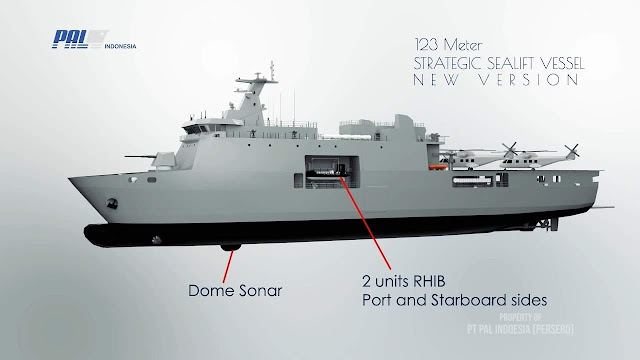 |
| Model of 123m LPD from PT PAL offered to the Philippine Navy. Photo c/o MaxDefense Philippines. |
The Philippines Department of National Defense (DND) has signed a contract with Indonesian state-owned shipbuilder PT PAL (Persero) for the supply and delivery of two new landing platforms dock (LPD) for the Philippine Navy (PN).
The contract worth PHP5.56 billion (US$107 million) was signed in Manila on 24 June 2022 by Philippine Defense Secretary Delfin Lorenzana and PT PAL Chief Marketing Officer Mr. Willgo Zainar, and witnessed by Philippine Navy Vice Commander Rear Admiral Caesar Bernard Valencia, PT PAL Corporate Secretary Mr. Rariya Budi Harta, General Manager of Marketing & Ship Sales Mr. Aris Wacana Putra, and other Philippine military and defense officials.
PT PAL offered a 123-meter LPD design, which is an improved version of the Tarlac-class LPD that PT PAL delivered to the Philippine Navy a few years ago.
The same design was featured by PT PAL in the recently concluded Philippine Marine Expo 2022 in Manila, and has a total length of 123 meters, a height of 21 meters, a displacement of 7,200 tons, and a cruising endurance of 30 days.
It would be powered by two marine diesel engines that allows a cruising speed of 13 knots, a maximum speed of 16 knots, and a maximum range of more than 9,300 nautical miles.
Allocation for future weapons and sensor systems are included in the design, which will be procured and installed later on by the Philippine Navy.
PT PAL noted that this is the second time that they will be exporting LPDs for the ASEAN market, and is touted as a measure of trust by the Philippine Government on the Indonesian shipyard’s ability to provide quality naval ships.
The DND is procuring these LPDs under the Landing Docks Acquisition Project of the Philippine Navy, which also includes a small landing crafts utility (LCU) and two Rigid Hull Inflatable Boats (RHIB) to come with each of the ships.
Delays have plagued the project due to several failed public biddings which pitted PT PAL with other shipbuilders from countries including South Korea, Malaysia, Netherlands, and India.
[1] PT PAL













